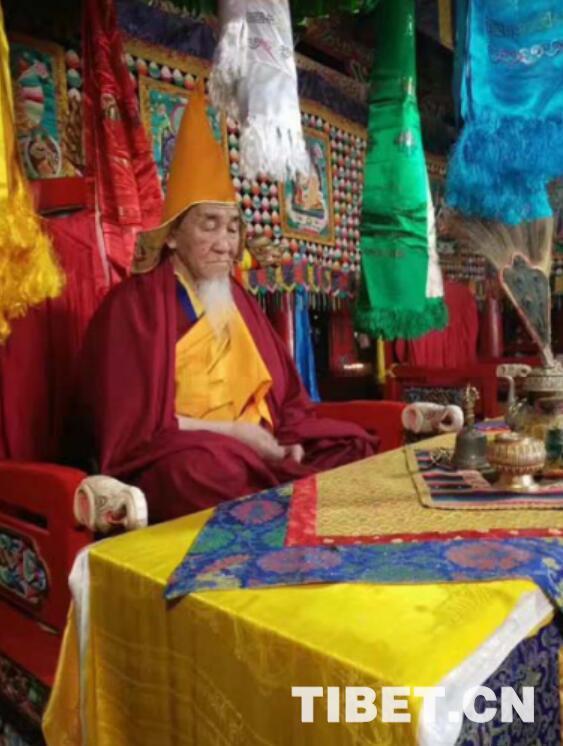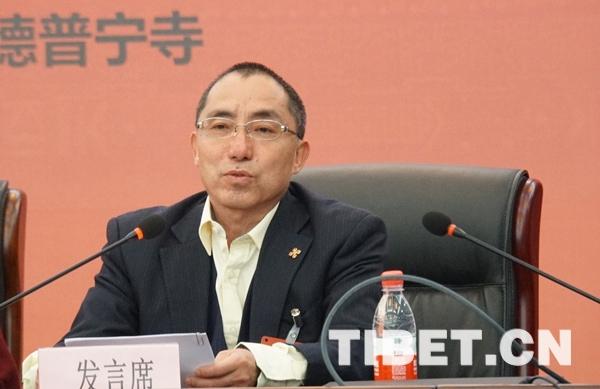On the 15th day of the fourth lunar month in 1981, a group of young people from the north came to the Lama Temple in Beijing to convert to Buddhism, and they began to study Mongolian-Tibetan Buddhism. At the same time, the Lama Temple invited high monks from great monasteries in Inner Mongolia such as Master Jamyang Thupden to teach Buddhist scriptures to the student monks. It also hired Hu Jiou, a teacher bilingual in Chinese and Tibetan languages from the Buddhist Academy of China, to teach Buddhist history.

Master Jamyang Thupden
Back then, Jamyang Kaichao, a Mongolian youth, was a student monk; he felt coming to the Lama Temple to learn was “a good thing!”. He recalled: “During our study of Tibetan Buddhism for a dozen years, the biggest difficulty in studying the scriptures or chanting sutras was that there was no suitable textbooks for Mongolian monks and laypeople to learn the Dharma. Considering this, it was imperative to compile textbooks for these student monks. Therefore, in addition to having a certain level of our mother tongue and Chinese language, we had to also learn Tibetan. When we first started learning Tibetan, we made a big effort to write down whatever the teacher taught us about the Dharma in Tibetan, Mongolian, and Chinese, and also to actively ask the teacher questions in our spare time.”

Jamyang Kaichao
Later, Jamyang Kaichao completed his studies of Mongolian-Tibetan Buddhism and various rituals at the Lama Temple. He went on to graduate from the High-level Tibetan Buddhism College of China and studied his master’s and doctoral degrees in Japan. He has also published many academic papers on the Pure Land in Mongolian-Tibetan Buddhism, Chinese Buddhism, and also Japanese Buddhism. He has since become a researcher at the Chinese Academy of Social Sciences Institute of World Religions.
The late Peking University Buddhist scholar Ji Xianlin once said, “Buddhism has affected almost all aspects of Chinese culture, adding new vitality to Chinese culture, promoting its development, and helping it grow. This is a recognized fact.” Looking back at history, especially since the Qing Dynasty, the Lama Temple has always played a role as a model for local Buddhist monasteries. It has also cultivated many outstanding monks with integrity, ability, profound knowledge, and who continue the excellence of the Buddha’s life. The Lama Temple also has a long history of Buddhist cultural exchanges with temples in Inner Mongolia, Hebei province, and even Mongolia.
“Since Reform and Opening-up in the 1980s, the Lama Temple has undertaken the Buddhist education, academic exchanges, and the inheritance and development of rituals of the major Buddhism sects for the Mongolian region (including Mongolia), Beijing, the three northeastern provinces (Jilin, Liaoning, and Heilongjiang provinces), Chengde, and Mt. Wutai, playing an important role in actively leading the historical transition from past to future,” Jamyang Kaichao told reporters. “In the past 40 years, the Lama Temple has continued to cultivate talented monks and successors for the inheritance and development of Buddhist culture in the Mongolian region. It has trained more than 500 monks who have become backbone of Buddhist activities and monastery management in religious circles of Beijing, Inner Mongolia, Liaoning, and Qinghai provinces.”
According to Jamyang Kaichao, the Lama Temple vigorously cultivates “three kinds of monk talents” these years: the studious talent (who can recite the classics and expound theories); the Dharma practice talent (who has good religious discipline); and the management talent (who compassionately serves others and intelligently manages affairs). “They are capable at doing, speaking, and writing”, so as to better spread the Dharma and serve the society.
Jamyang Kaichao said, during these years, we not only pay attention to classroom teaching and monks’ self-management and Dharma practice; at the same time, we continue to carry out practical teachings and organize monks to go out and study. For the past few decades, six monks from the Lama Temple have graduated from the High-level Tibetan Buddhism College of China, eight have graduated from the Buddhist College at Labrang Monastery in Gansu province, and still others have graduated from other colleges and universities. The Lama Temple has also sent around 10 monks to large and small monasteries in Mongolia to serve as abbots or teachers in local monasteries. These are all outstanding contributions made by talents and Buddhist successors trained at the Lama Temple in the 40 years since Reform and Opening-up.
Editor:Yanina
